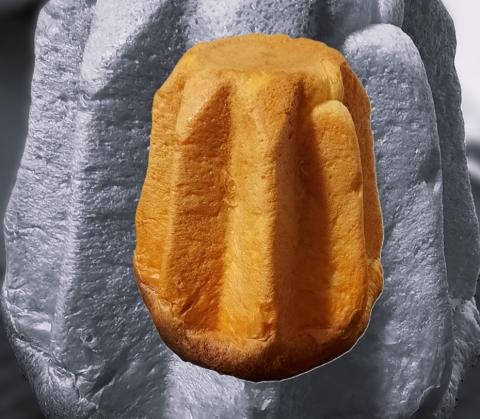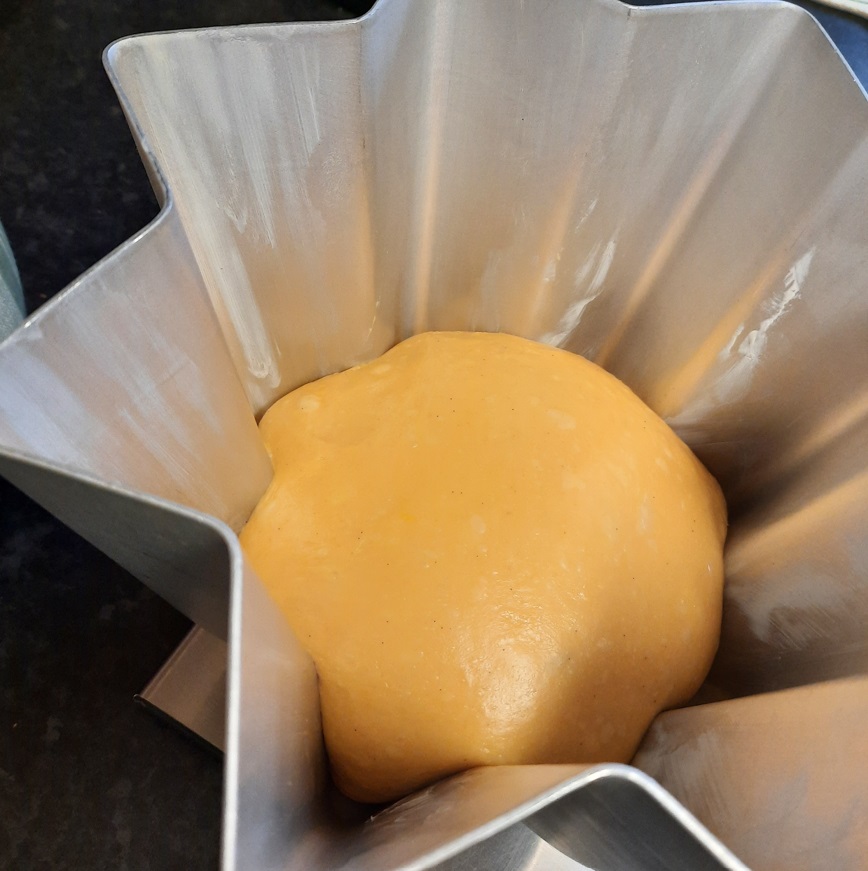
Pandoro A Due Impasti di Giorilli

Formula:
| Pandoro A Due Impasti di Giorilli | |||
| Original | 1x1Kg | ||
| Primo Impasto | (g) | (g) | |
| Flour | 2000 | 286 | |
| LM | 500 | 71 | |
| Sugar | 600 | 86 | |
| Whole eggs✝ | 1650 | 236 | |
| Butter | 700 | 100 | |
| Salt | 4 | 0.57 | |
| Secondo Impasto | |||
| Flour | 350 | 50 | |
| Malt | 25 | 3.57 | |
| Egg yolks | 350 | 50 | |
| Salt | 22 | 3.14 | |
| Emulsion | |||
| Sugar | 350 | 50 | |
| Honey | 50 | 7 | |
| Butter | 750 | 107 | |
| Cocoa butter✝✝ | 170 | 24 | |
| Flavourings* | |||
| To Finish the mix | |||
| Fresh cream | 140 | 20 | |
| Total | 7661 | 1094 | |
* Additional flavourings were added: After mixing the primo impasto, honey from the recipe was mixed with vanilla, lemon zest and a splash of dark rum. This was left to infuse overnight before being mixed into the emulsion the following day.
✝ A splash of milk (UK: Semi skimmed) was added to 4 whole eggs (UK: large) to make up the desired weight of 236g.
✝✝ Cocoa butter was substituted with quality white chocolate.

Method:
Per il primo impasto, begin by mixing the flour with the leaven and almost all the eggs. When the dough becomes smooth, add the remaining eggs. After a few minutes incorporate the sugar, the salt and the lastly the butter. Let it rise at 25-26C for around 12 hours or when it reaches triple the volume.
Per il secondo impasto, mix half of the first dough with the flour and the malt. When the dough becomes smooth add the other half, the salt and lastly the egg yolks, a little at a time. When the dough is elastic and homogenous incorporate the emulsion, prepared in advance by creaming the butter with sugar and amalgamating well the other ingredients. Finish the mix adjusting the consistency with the fresh cream.
Transfer to a container and let rest for around 30 minutes at 28C. After this time, scale pieces of the desired weight, shape into a boule and place on butter boards and hold them at 28C for around 60 minutes. Shape and place in the moulds. Allow to rise at 28-30C for around 6 hours or until the dough reaches the edges of the mould.
Baking times:
500g: 30 minutes at 170C
750g: 40 minutes at 170C
1000g: 50 minutes at 170C
Remove from the oven and let the pandoro cool for around 60 minutes before removing from the mould.
-------------------------------------------------------------------------

LM - Not fully tripled but pleasant alcohol aromas within.

Primo Impasto - After12 hours the primo impasto more than tripled in volume!
The leavening power of my lievito madre is proving very potent. However acidity issues persist. Primo impasto pH: Initial: 6.27 End: 4.21. It just goes to show that simply pushing the yeast potency is not enough to mitigate acidification.
The risen primo impasto had quite a strong acetic aroma emanating from it while on the counter, however the taste was very different and tasted completely non-sour with just a very pleasant carbonic fizz.
The final mix was relatively easy to do and went without issue. By the end of the mix the finished dough was supple and elastic and when removed from the mixing bowl was a very extensible and relaxed to cover a large part of the counter. pH = 4.5 (too low - should be >5).
I rounded the dough a couple of times during the rest period to encourage it to hold a higher form before performing the final round and placing into the pandoro mould.

Finished dough - After mix rest then rounded (pagnottella)


Finished dough moulded

Fully proofed
The proof was done at a slightly lower temperature of 24-25C than the 28-30 prescribed. Proof time 9 hours instead of 6 but that's about right considering the temperature difference.


Baked
Just in time for Christmas, I wanted to get a Holiday bread bake in before the festive season began. It's been years since I baked a Pandoro and I'm glad I did. Being less dicey than Panettone since it doesn't require hanging which can be make or break!
Happy Christmas all.
Michael


Comments
That is marvelous and I bet delicious. Happy Holidays Michael.
Benny
Thanks Benny. Wishing you and those closest to you a very merry Christmas.
Michael
Amazing rise, Michael - it really is a spectacular looking product and I'm sure it must taste as good as it looks.
I did read that if low primo pH is from acetic, you are in with a chance, but if it is from lactic you are snafu. - not sure if true or not.
Lance
Thanks Lance. I'm doing something a little different from the typical maintenance to focus on maximising leavening power. At least this way it is not so dispiriting, and I can get a finished product. The last step is to fix the acidity issues, which I already know in theory (I think) how to fix but the practice is a little more tricky.
Acetic primo vs lactic primo - Sure, I'd go along with that. Too much lactic in the primo has a deleterious effect on gluten structure and dough rheology properties. Typically this results in the second dough breaking during butter incorporation or a product that falls from its mould.
The presence of too much acetic acid that follows through into the finished product is sour tasting and irritates the mouth (teeth and gums) during eating.
I am finding this Panettone game a frustrating business, Michael! So much work and I do feel rather uncomfortable with the flour wastage; I tried using small amounts, but it does not seem to work well.
Of course the frustration comes from training the LM - I'm now pretty happy with the way I mix the impastos.
As an example, I thought I had got my LM in reasonable shape (but not with great rising power), so I decided to do the 3 refreshments and make the primo, expecting a poor rise. In actual fact when I came down in the morning, the dough had nearly quadrupled! But the downside was that the pH was 4.43....
I decided to attack this value with a brute force approach - after all, if bagels and pretzels are boiled in a sodium hydroxide bath, I'm sure a bit of NaOH won't do my impasto (or its consumers) any harm, presumably making sodium acetate and sodium lactate. So after a trial titration with 0.1M NaOH, I worked out I needed 0.5g NaOH (food grade, of course) to get the pH up to about 5. So I dissolved this in 18ml water and added it to the primo and ended up with a pH of 4.9.
The secondo mixed fine and eventually I ended up with panetonne, but not good enough to show here (sunken top) and a rise time of 11 hours - I've had this before. I'm thinking that maybe if the primo size increase is too much then the dough gets exhausted. Really the primo needs monitoring for rise and pH, but I think I will draw the line at staying up all night!
Probably the best thing is to attend a course, eg Sourdough Slingers https://www.instagram.com/reel/Cyiu_rStcUB/ but that's a big commitment and a long way from me.
Do share with us if you have an Epithany!
And all the best to you and all the other panettone troopers on TFL.
Lance